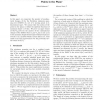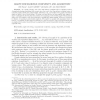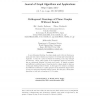108
Voted
SIROCCO
2008
15 years 2 months ago
2008
In the effort to understand the algorithmic limitations of computing by a swarm of robots, the research has focused on the minimal capabilities that allow a problem to be solved. ...
CATS
2008
15 years 2 months ago
2008
Using eigenvalue analysis, it was shown by Erd
108
click to vote
CCCG
2010
15 years 2 months ago
2010
In this paper, we enumerate the number of combinatorial changes of the the Euclidean minimum spanning tree (EMST) of a set of n moving points in 2dimensional space. We assume that...
94
Voted
ESA
2006
Springer
15 years 4 months ago
2006
Springer
A coloring is proper if each color class induces connected components of order one (where the order of a graph is its number of vertices). Here we study relaxations of proper two-c...
COMPGEOM
1994
ACM
15 years 4 months ago
1994
ACM
We consider the problem of bounding the combinatorial complexity of a single cell in an arrangement of n low-degree algebraic surface patches in 3-space. We show that this complex...
102
click to vote
IPPS
1999
IEEE
15 years 4 months ago
1999
IEEE
This paper proposes a method for reducing the maximum degree of vertices in graphs that maintain optimal broadcast time when a vertex can call a vertex at distance at most k durin...
105
Voted
WG
2001
Springer
15 years 5 months ago
2001
Springer
In a graph coloring, each color class induces a disjoint union of isolated vertices. A graph subcoloring generalizes this concept, since here each color class induces a disjoint un...
115
click to vote
GD
2001
Springer
15 years 5 months ago
2001
Springer
In an orthogonal drawing of a plane graph each vertex is drawn as a point and each edge is drawn as a sequence of vertical and horizontal line segments. A bend is a point at which...
89
Voted
SPAA
2003
ACM
15 years 5 months ago
2003
ACM
This paper proves that for every positive integers n and k, we can explicitly construct a graph G with n+O(k) vertices and maximum degree 3, such that even after removing any k ve...
106
Voted
COMPGEOM
2004
ACM
15 years 6 months ago
2004
ACM
We prove that the geometric thickness of graphs whose maximum degree is no more than four is two. In our proofs, we present a space and time efficient embedding technique for gra...



